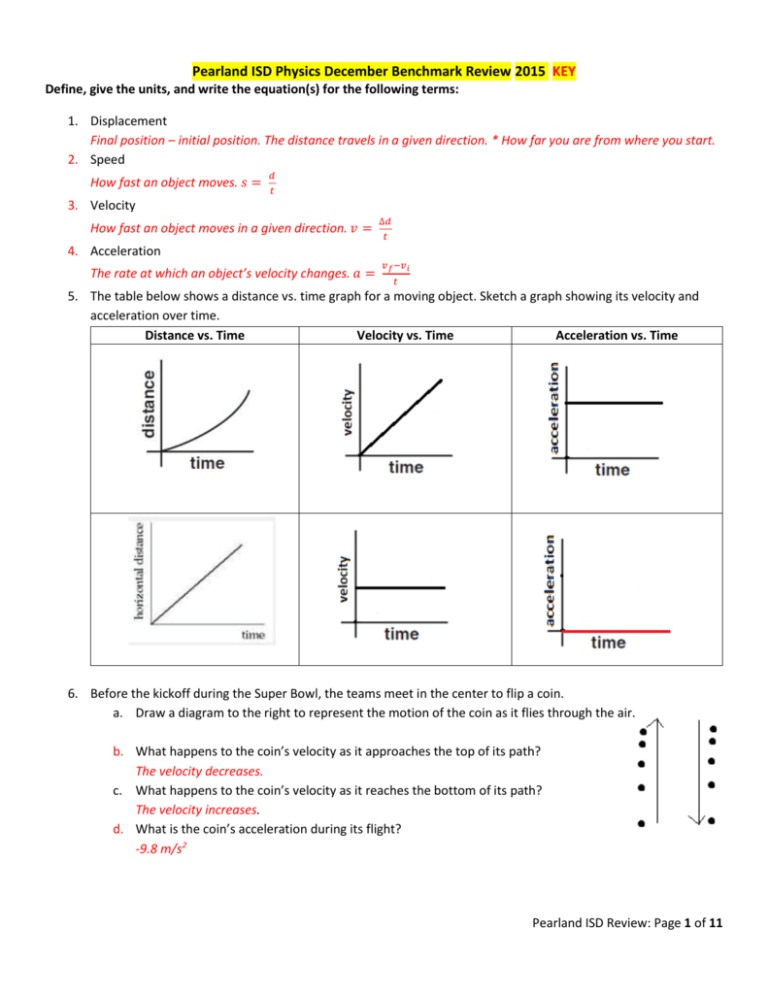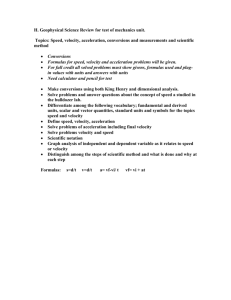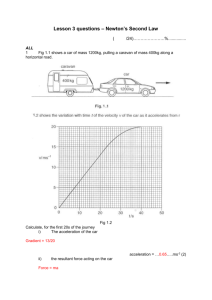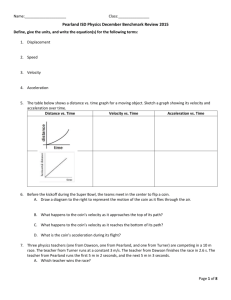Pearland ISD Physics Benchmark Review - KEY
advertisement

Pearland ISD Physics December Benchmark Review 2015 KEY Define, give the units, and write the equation(s) for the following terms: 1. Displacement Final position – initial position. The distance travels in a given direction. * How far you are from where you start. 2. Speed How fast an object moves. 𝑠 = 𝑑 𝑡 3. Velocity How fast an object moves in a given direction. 𝑣 = ∆𝑑 𝑡 4. Acceleration The rate at which an object’s velocity changes. 𝑎 = 𝑣𝑓 −𝑣𝑖 𝑡 5. The table below shows a distance vs. time graph for a moving object. Sketch a graph showing its velocity and acceleration over time. Distance vs. Time Velocity vs. Time Acceleration vs. Time 6. Before the kickoff during the Super Bowl, the teams meet in the center to flip a coin. a. Draw a diagram to the right to represent the motion of the coin as it flies through the air. b. What happens to the coin’s velocity as it approaches the top of its path? The velocity decreases. c. What happens to the coin’s velocity as it reaches the bottom of its path? The velocity increases. d. What is the coin’s acceleration during its flight? -9.8 m/s2 Pearland ISD Review: Page 1 of 11 7. Three physics teachers (one from Dawson, one from Pearland, and one from Turner) are competing in a 10 m race. The teacher from Turner runs at a constant 3 m/s. The teacher from Dawson finishes the race in 2.6 s. The teacher from Pearland runs the first 5 m in 2 seconds, and the next 5 m in 3 seconds. a. Which teacher wins the race? 𝑥 The teacher from Dawson wins. Use the speed equation 𝑠 = 𝑡 for each person. b. What is the teacher from Pearland’s average speed during the race? 𝑥 10𝑚 𝑠= 𝑠= = 2 𝑚/𝑠 𝑡 5𝑠 8. A boat travels 12.0 m while it reduces its velocity from 9.5 m/s to 5.5 m/s. What is the magnitude of the boat’s acceleration while it travels the 12.0 m? formula: vf2=vi2 + 2a(xf - xi) Re-arranged for unknown: a = (vf2 - vi2)/2(xf - xi) a = (5.5)2 − (9.5)2 / (2(12 – 0)) 𝑎 = −2.5 𝑚/𝑠 2 9. A tourist is standing close to the top of the Eiffel tower, 300.0 m above ground, and accidentally drops his camera. How long will the camera take to hit the ground? 1 2 Formula: ∆𝑋𝑦 = 𝑎𝑡 2 Re-Arranged Formula: t = √(2∆𝑋𝑦/a) t = √(2 ∗ −300/-9.8) 𝑡 = 7.8 𝑠 10. The graph to the right represents the motion of an object over a period of 14 seconds. Fill out the table below describing the motion and calculating the displacements, velocities, and accelerations for each segment. An example is done for you for segment A. Pearland ISD Review: Page 2 of 11 Segment Motion Displacement Velocity ∆𝑥 𝑣= ∆𝑡 6𝑚 𝑣= 2𝑠 v = 3 m/s Acceleration A Moves in the positive direction with a constant velocity. ∆x = xf-xi = 3 - -3 =6m B Rests for 3 seconds. 0m 0 m/s 0 m/s2 C Moves in the negative direction with a constant velocity. -6 m -6 m/s 0 m/s2 D Rests for 1 second. 0m 0 m/s 0 m/s2 E Moves in the negative direction at a constant velocity. -3 m -3 m/s 0 m/s2 F Rests for 2 seconds. 0m 0 m/s 0 m/s2 G Moves in the positive direction with a constant velocity. 4m 1 m/s 0 m/s2 ∆𝑣 ∆𝑡 0 𝑎 = 2𝑠 = 0 𝑎= Questions 11-14 refer to the table and figure in Question 10. 11. For the segments where the acceleration is zero, explain why. Each segments moves at a constant velocity, so there is no acceleration. 12. In which segment is the object moving the fastest? Segment C How do you know when the object is moving the fastest? It has the steepest slope. It also has the largest magnitude. 13. What is the object’s overall displacement during the 14 seconds? 1 m 14. What is the object’s average speed during the 14 seconds?19m/14s = 1.36 m/s Pearland ISD Review: Page 3 of 11 15. The speed of a car is decreased at a rate of 4.0 m/s2 from 35 m/s to 10 m/s. Over how many seconds does this process take place? ∆v a= ∆t Rearrange equation for time and solve t= ∆v a = 35-10 4 = 6.3 s Define the following terms: 16. Scalar A measurement with only magnitude. 17. Vector A measurement with both magnitude and direction. 18. Resultant The sum of multiple vectors. 19. Projectile An object that launches into the air with both vertical and horizontal motion. The path is shaped as a parabola. Use the diagram below to answer questions 19-21 20. Write one sentence to compare the horizontal velocity of the baseball above at points V and Y. The horizontal velocity at points V and Y are equal. The horizontal velocity is equal at all points. 21. Write one sentence to compare the vertical velocity of the baseball above at points Y and Z. The vertical velocity at point Y is lower than at point Z. 22. What is the vertical velocity of the baseball above at point W? The vertical velocity at point W is 0 m/s. 23. In the diagram to the right, the archer shoots an arrow forward with a velocity of 20 m/s. It hits the ground 0.55 s later. From how high is the archer shooting the arrow? 1 ∆𝑋𝑦 = 𝑎𝑡 2 2 1 ∆𝑋𝑦 = (9.8)(. 55)2 2 ∆𝑋𝑦 = 1.5 𝑚 Pearland ISD Review: Page 4 of 11 Define the following terms: 24. Force A push or a pull on an object. 25. Newton’s 1st Law An object at rest stays at rest and an object in motion stays in motion unless acted upon by an unbalanced force. 26. Newton’s 2nd Law The force and acceleration of an object are directly proportional. The mass and acceleration of an object are inversely proportional. F = ma, a = F/m 27. Newton’s 3rd Law Every action force has an equal in magnitude but opposite in direction reaction force. 28. For each diagram below, describe the net force acting on the object, and find its acceleration. a. 40 N 20 kg b. 20 N 𝐹 = 𝑚𝑎 20 𝑁 = (20𝑘𝑔)𝑎 𝑎 = 1 𝑚/𝑠 2 10 N 5 kg 𝐹 = 𝑚𝑎 20 𝑁 = (5𝑘𝑔)𝑎 𝑎 = 4 𝑚/𝑠 2 30 N c. 2 kg 15 N 10 N 1st use Pythagorean Theorem to find Force F = √(102 + 152), F = 18N 2nd use: a = F/m 𝑎 = 18/2 𝑎 = 9.0 𝑚/𝑠 2 29. What is the net force acting on a 10 kg object that produces an acceleration of 30 m/s2? 𝐹 = 𝑚𝑎 𝐹 = (10𝑘𝑔)30 𝑚/𝑠 2 𝐹 = 300 𝑁 Pearland ISD Review: Page 5 of 11 30. Consider a book of mass 2 kg. a. Calculate the book’s weight. 𝐹 = 𝑚𝑎 𝐹 = (2𝑘𝑔)(9.8 𝑚 ) 𝑠2 𝐹 = 19.6 𝑁 b. Draw a free body diagram for the book as it rests on a table. c. What is the net force acting on the book? Net force = 0 N This explains why it is not moving. 31. A little boy pushes a wagon with a force of 10 N. How much force does the wagon exert on the boy? According to Newton’s 3rd Law, the force must be equal and opposite. 10 N. 32. A grocery bag is being carried from a car into a house. Draw a free body diagram for the grocery bag. 33. A car is being towed up a hill. Draw a free body diagram for the car. Remember your normal force is perpendicular to the surface Pearland ISD Review: Page 6 of 11 34. Which way would each of the following boxes move? What would be the magnitude of the force? 10 N to the right Either at rest or moving with constant velocity Use Pythagorean Theorem F = √(102 + 102) F = 14.1 N 5 N to the left 35. You are riding in a bus that is moving at a speed of 60 km/h. If you walk from the back to the front of the bus at a speed of 10 km/h, your speed relative to the ground would be ___50km/h forward______. 36. A school bus is traveling to the Rig at speed of 20 m/s. A student on the bus throws a Frisbee horizontally at 15 m/s toward the back of the bus. From the perspective of an observer on Oiler Drive outside the bus, the Frisbee appears to move at a speed of ___5m/s forward___. 37. Bruce is walking east at 1.25 m/s on a moving sidewalk in an airport that is moving east at 3 m/s. How fast is Bruce walking when viewed by Marcy, who is standing still nearby eating an ice cream cone? 4.25 m/s East 38. In order to get to the beach from your house on Galveston you must walk 9 km east then 7 km south before reaching the beach. What is the magnitude of the straight line path you could have taken to reach the beach? Show your work! Use Pythagorean Theorem F = √(92 + 72) F = 11.4 N Pearland ISD Review: Page 7 of 11 39. A bus is moving at 45 m/s north. Which of the following is a vector quantity? A. the speed of the car B. the velocity of the car C. the potential energy of the car D. the distance traveled by the car 40. A 2000 kg car is pulling a 1000 kg trailer. The car’s engine exerts a 7000 N force to move the car and the trailer. In addition, the car and the trailer each experience a 900 N frictional force as they are being pulled. What is the net force on this system? 7000N pulling forward and 900 N friction from the car and 900 friction from the trailer. 7000 – 900 – 900 = 5200N 41. A person leaves a house and walks five blocks north, then walks three blocks west. In what direction is the displacement of the person, relative to the starting point? __North West___ What is the magnitude of their displacement? Show your work! Use Pythagorean Theorem F = √(32 + 52) F = 5.8 N NW 42. Describe the direction of centripetal force. Rearrange the formula for centripetal acceleration for r and then for v. Centripetal force is pointed towards the center of the circle. Main Equation: ac = v2/r Solved for r: r = v2/ac Solved for v: v =√(acr) 43. A tied to a string moves in a circle that has a radius of 0.5m. If the ball is accelerating at 36m/s2, what is the tangential velocity of the ball? vt2 ac = r Solve for Vt: Vt = √(𝑎𝑐 𝑟) Vt = √(36 ∗ .5) = 13.4 m/s 44. Andre has two boxes of equal mass that are two meters apart. He moves Box B so that it is 4 meters away from Box A. In order for the gravitational force between the boxes to remain the same before and after moving the boxes, what must happen to the weight of each box? If the distance between the boxes doubles the mass must also double to keep the same gravitational force. Pearland ISD Review: Page 8 of 11 45. Two spheres, 1.00 kg each, are 2.00 m apart. What is the gravitational force between them? Fg = G m1m2 r2 = 6.67 x10-11 *1*1 22 Fg = 1.7 x 10-11 N 46. What scientist is associated with the Universal Law of Gravitation? Write the formula and the units of each variable. Isaac Newton Force – Newtons Mass – Kilograms Radius (distance between the masses) - Meters 47. A child is on a sled moving down a hill at 20 m/s. The combined mass of the sled and child is 100 kilograms. What is the momentum of the child and sled? P = mv P = 100*20 = 2000 kg·m/s 48. When is linear momentum conserved? The total momentum of all objects interacting with one another remains constant. Regardless of the nature of the forces between the objects, Momentum is conserved in collisions. 49. Which of the following has the least momentum? Show your work! A A 0.5 kg mass with a 1000 m/s velocity 0.5*1000 = 500 kg·m/s B A 1.0 kg mass with a 1000 m/s velocity 1 * 1000 = kg·m/s C A 10 kg mass with an 11 m/s velocity 10 * 11 = 110 kg·m/s D A 100 kg mass with a 2 m/s velocity 100 * 2 = 200 kg·m/s 50. At an amusement park, bumper car X moves at a speed of 2.5 m/s toward car Y, which is at rest. Car X collides with Car Y. A. Describe how the momentum of each car changes after the collision. Some of the momentum of Car X will transfer to Car Y B. If given that Car X and rider has a mass of 52 kg and Car Y and rider has a mass of 67 kg, and the final velocity of Car X is 1.7 m/s, calculate the final velocity of Car Y. Show your work! Total Initial Momentum = Total final Momentum (52*2.5) + (67*0) = (52*1.7) + (67*vf) 130 + 0 = 88.4 + 67vf (130-88.4)/67 = vf vf = 0.6 m/s Pearland ISD Review: Page 9 of 11 51. What impulse must be applied to a 25.0-kg cart to cause a velocity change of 12.0 m/s? Impulse = change in momentum Impulse = m∆v Impulse = 25*12 Impulse = 300kg·m/s 52. A 0.25 kg block is traveling along a horizontal, frictionless surface at a speed of 2.8 m/s. The block hits a wall and returns in the opposite direction at a speed of 1.7 m/s. What is the approximate impulse of the block on the wall? Impulse = change in momentum Impulse = m∆v = mvf - mvi Impulse = (0.25*-1.7) – (0.25*2.8) Impulse = -1.1 kg·m/s 53. A 3000 kg bus can accelerate from rest to 30 m/s in 9s. What is the net force acting on the bus to cause this acceleration? First you must find the acceleration a = ∆v/∆t, a = (30-0)/(9-0) = 3.3 m/s2 Then you can find force F = ma, F = 3000*3.3 = 9900N 54. A soccer ball is kicked horizontally at 15.8 m/s off the top of a field house and lands 33.9 meters from the base of the field house. Determine the height of the field house. Horizontal Components: Vx = 15.8 m/s and ∆Xx = 33.9m Vertical Components: a = -9.8 m/s2 Unknown: ∆Xy Use Horizontal components to find Time: Vx = ∆Xx/T, solved for time, T = ∆Xx/Vx T = 33.9/15.8 = 2.1s Then solve for vertical distance ∆Xy = ½ a∆T2 ∆Xy = ½ (-9.8*2.12) ∆Xy = 21.6m Pearland ISD Review: Page 10 of 11 55. A ball is projected horizontally from the top of a 92.0-meter high cliff with an initial speed of 19.8m/s. Determine the horizontal distance traveled. Horizontal Components: Vx = 19.8 m/s Vertical Components: a = -9.8 m/s2, and ∆Xy = -92m Unknown: ∆Xx Use vertical components to find time 1 ∆𝑋𝑦 ∆T = √2 𝑎 1 −92 2 ∆T = √ −9.8 = 2.2s Use Horizontal components to find Time: Vx = ∆Xx/T, solved for ∆Xx, ∆Xx = ∆TVx ∆Xx = ∆TVx ∆Xx = 2.2*19.8 ∆Xx =43.6m 56. A plane drops a rescue capsule from an altitude of 8500 m. How long does it take for the capsule to fall to Earth, assuming air resistance is negligible? Horizontal Components: none Vertical Components: a = -9.8 m/s2, and ∆Xy = -8500m Unknown: Time Use vertical components to find time 1 ∆𝑋𝑦 ∆T = √2 𝑎 1 −8500 2 ∆T = √ −9.8 = 20.8seconds 57. If you were to drop a golf ball, a soccer ball, a bowling ball and a tennis ball from a height of 100m, if there was no air resistance which one would hit the ground first. They would all hit the ground at the same time. Pearland ISD Review: Page 11 of 11








